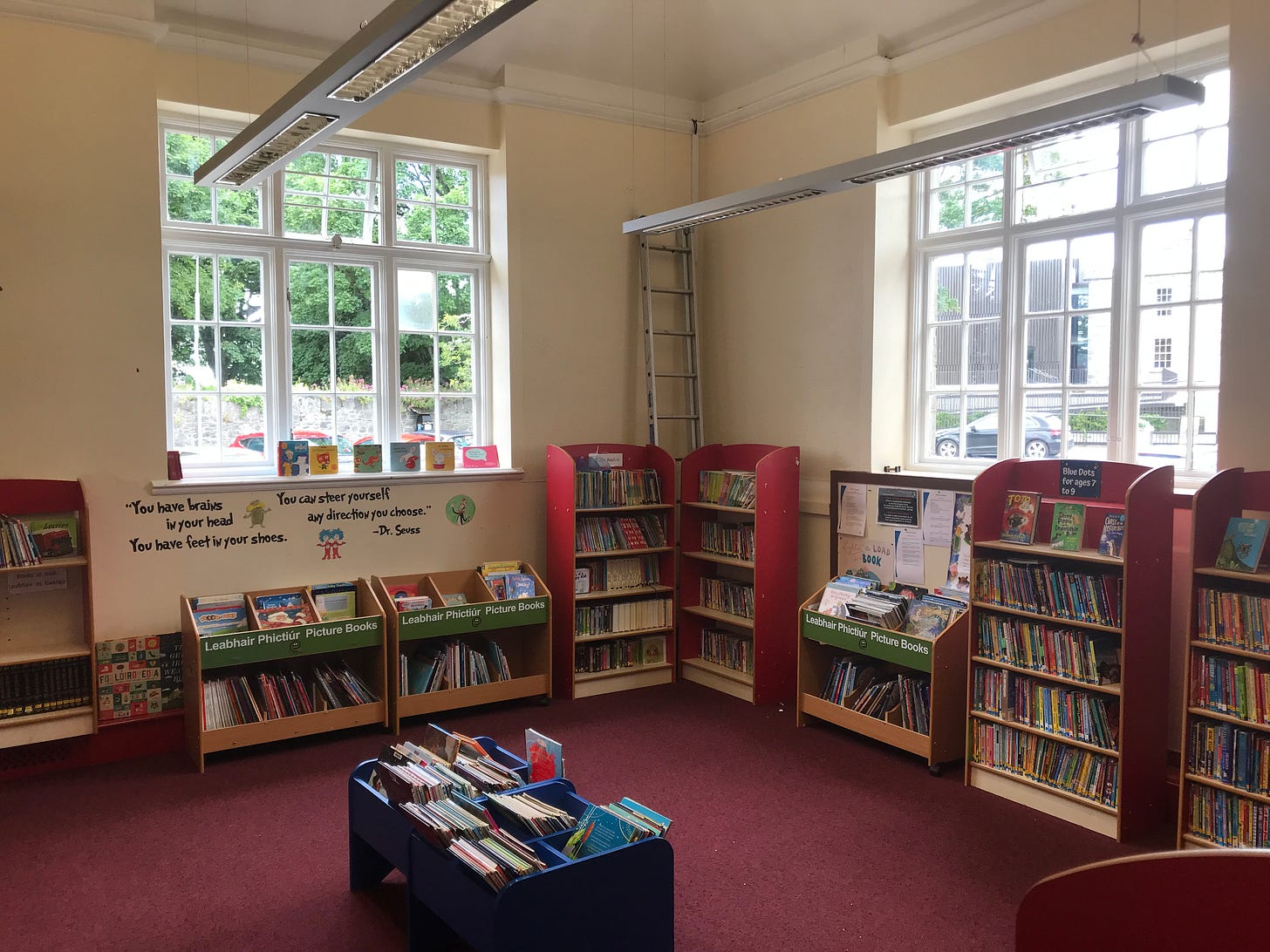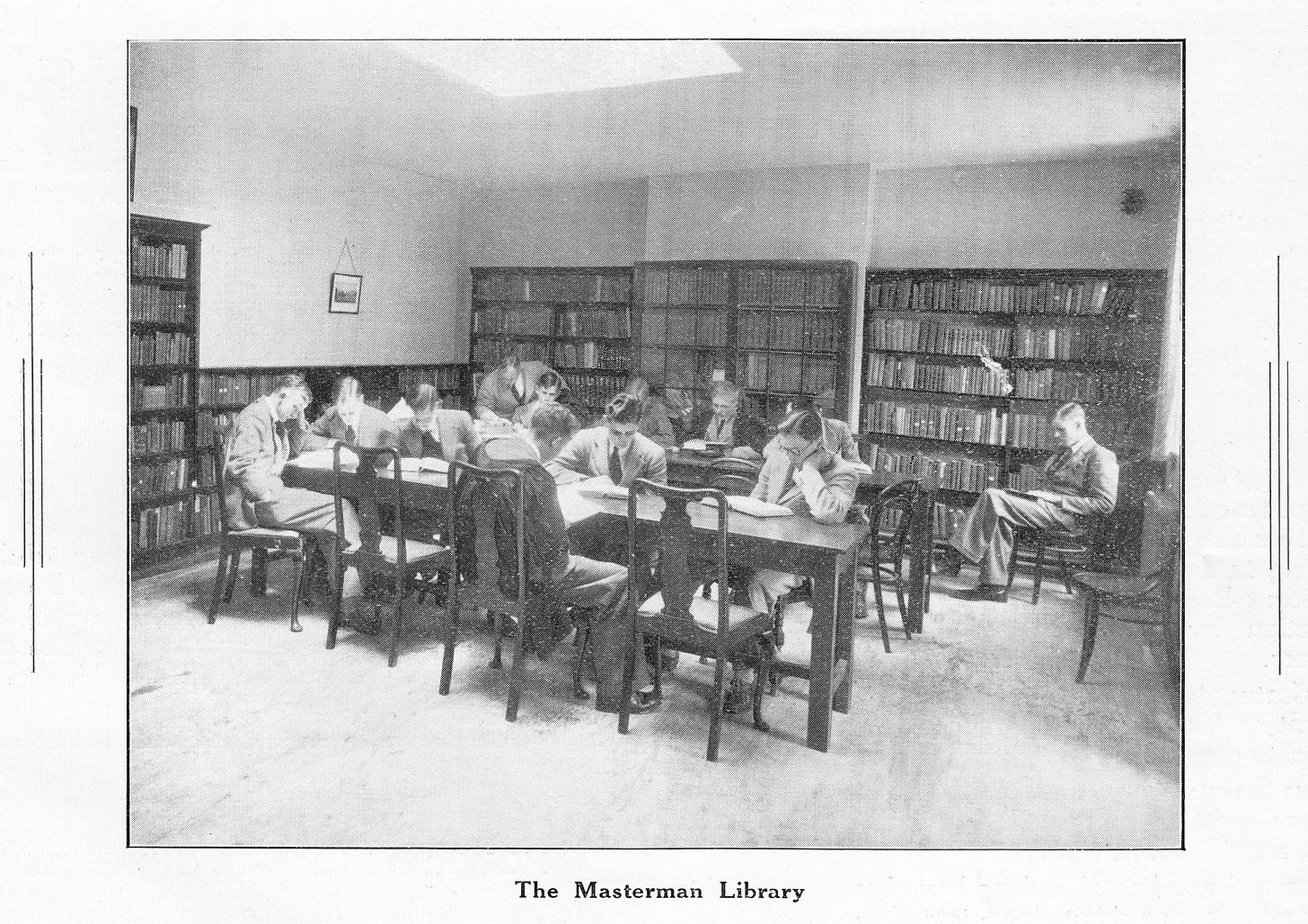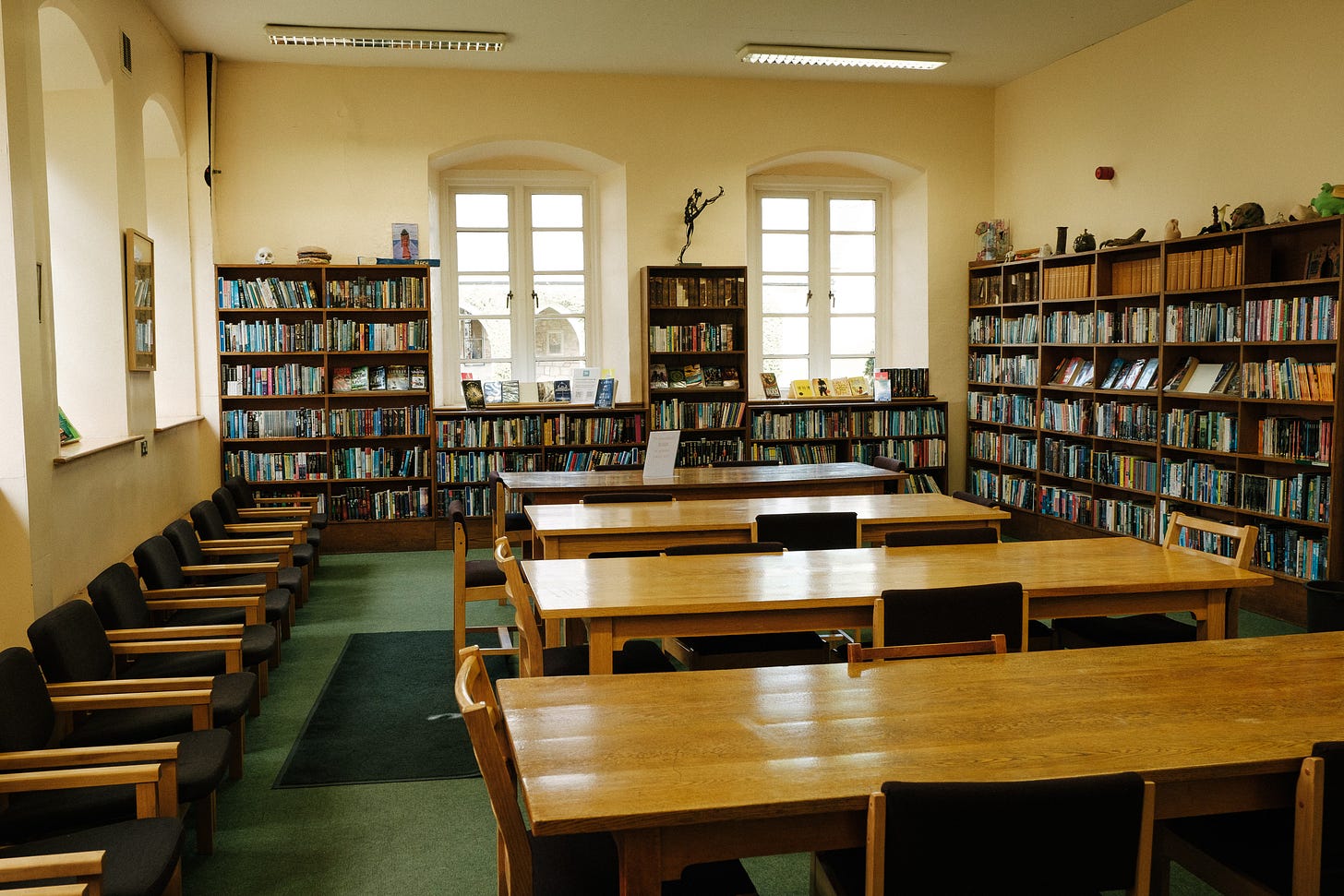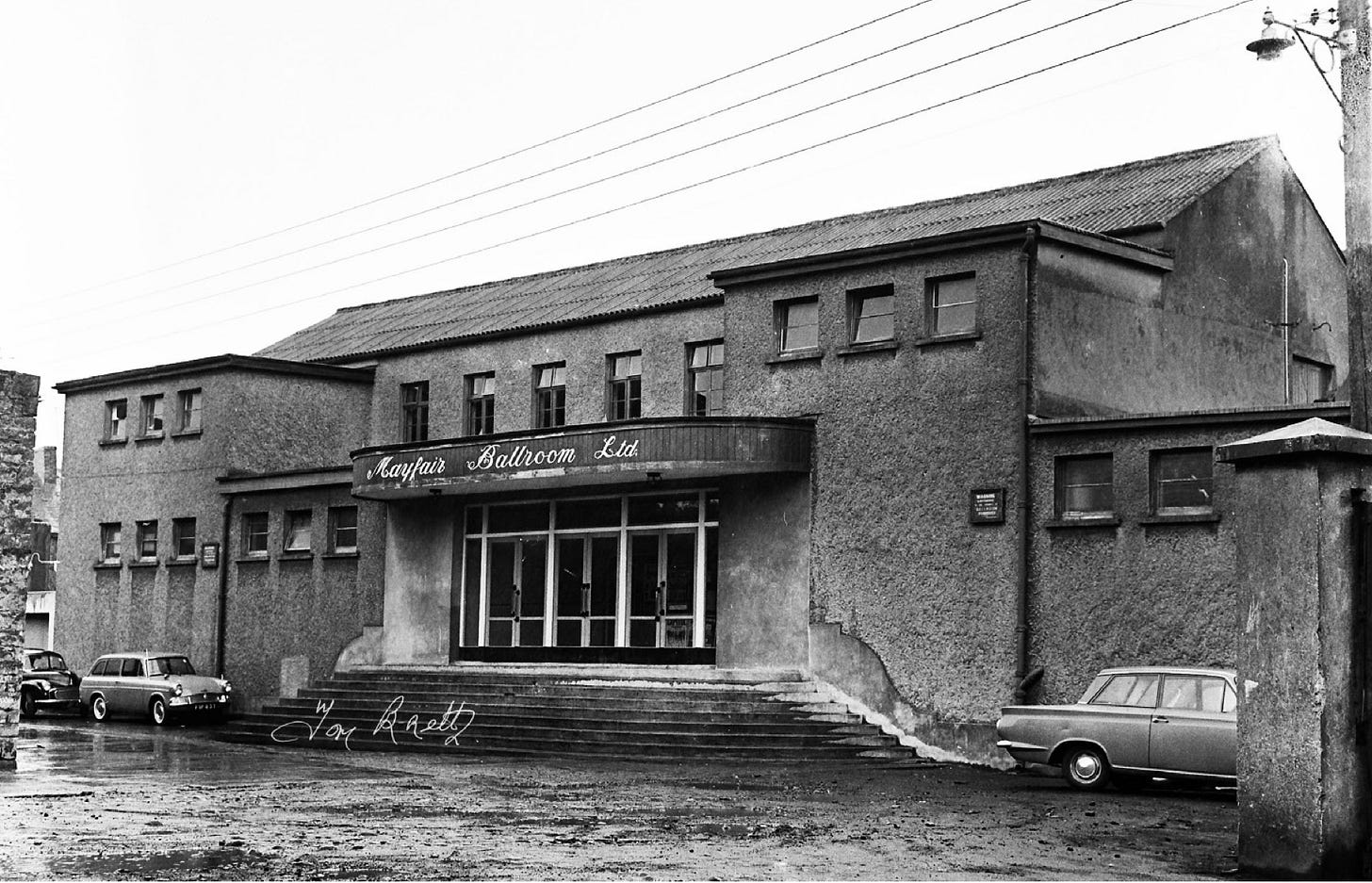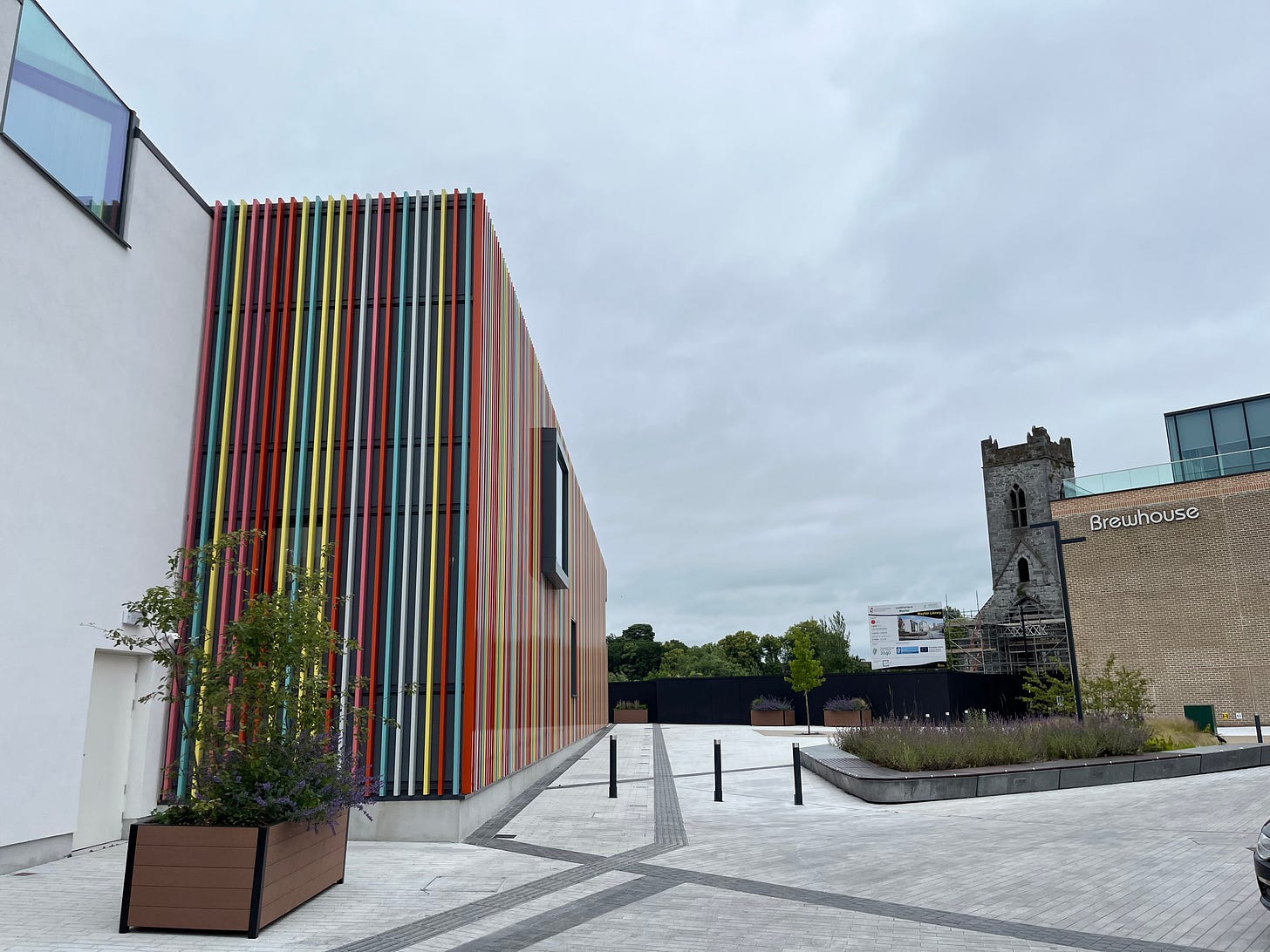A love letter to libraries
A modified and updated version of a post from early 2024 on the joys of libraries, especially for the many new subscribers since then.
Earlier this week I visited the original library mentioned in this post, so I thought it was worth updating and sharing the essay again.
Moreover, today is Ireland Reads Day, a ‘national celebration of reading’, and libraries here are open on Saturdays, so …
The Fortnightly will be back this time next week: issue 183.
Libraries make me happy. All libraries.
It doesn’t matter whether I’m entering an all-singing all-dancing architectural marvel, like the DLR Lexicon in Dún Laoghaire, or a fraying nineteenth century building that badly needs replacement. Over the years I have used libraries that were based in a range of places ranging from a small locked cupboard in a school to a world-famous 400 year-old beauty. But when I step over the threshold into any library, something magical happens: always, a feeling of being at home and in just the right place.
Libraries are communal and often democratically open places, places where there is a pleasing common purpose. As Eileen Culloty of DCU wrote just yesterday for RTÉ Brainstorm,
Tech companies often describe their platforms as communities. This self-serving rhetoric makes them sound like quaint, self-governed entities when they are, of course, corporations that exploit their users for commercial gain. Online platforms are awash with scams, hatred, and conspiracy theories. If these spaces are communities, they are toxic ones—shaped not by collective values, but by algorithms that prioritise 'engagement'. Public libraries are a refuge from this chaos. Libraries have long been spaces for learning and access to knowledge, but their role today goes far beyond borrowing books and providing internet access. They are beacons for all members of the community offering everything from storytelling and exhibitions to meeting rooms and language classes.
Despite the arrival of online catalogues, wi-fi and 3-D printers, libraries are still primarily analogue and physical experiences in a world of transient digital life. As such, they were particularly missed during the pandemic. And of course they serve lots of roles beyond book-borrowing and studying - courses, kids’ groups, film shows, hobby clubs, warmth. Even mitching, which of course I don’t recommend: in his book Making Kids Cleverer: a manifesto for closing the advantage gap, David Didau writes about skipping off school as a boy by using his free bus pass to escape into the city:
Where do you go if you’re a 13 year-old with no money in the middle of England’s second biggest city? The library, obviously. Birmingham Central Library was my refuge, my sanctuary and, in some ways, my alma mater. Not only was it warm, but it was big enough that a teenager in school uniform went unnoticed … for some unknowable reason I became a devotee of Russian literature: I read Crime and Punishment, The Gulag Archipelago, The Master and Margharita and Anna Karenina. I didn’t understand them all that well - and I certainly didn’t like them all - but I stubbornly ploughed through them, day after day. And no one in the library ever questioned my right to do so.
Whatever other faults Irish society has, despite our economic privilege, there is this one area of life that is flourishing and, frankly, magnificent. Every other week we see reports from our neighbours across the water about the erosion of the public library system there. Well, not here. The Irish library system is thriving. New or superbly refurbished buildings regularly open: see Kinsale, and Kildare, and Naas for a start. At the Samuel Beckett Civic Centre in nearby Ballyogan a new library is opening any day now. For another example, wait for the end of this post to read about the new Mayfair Library in Kilkenny City, which opened last summer and carries for me a very personal connection.
Moreover, in addition to the excellence of the library staff in Ireland (I’ve never come across a librarian who is anything other than helpful and pleasant), how amazing is it that we have an online ordering system like we do? You can go online anywhere, find a book that is not in your own library, if currently available order it from another part of the country, and a few days later collect it from your local branch. Amazing. For free! Also, fines for late returns were wisely abolished a few years ago (they don’t encourage returns).
So, a love letter to the libraries throughout my life:
The first: the ur-library, where it all began, was the Carnegie on John’s Quay, Kilkenny. A sturdy compact stone building from 1910 with windows at the front, flanking pillars at the entrance and a cupola, with views to the Castle and the main city across the River Nore. Over the door, letters cut into the stone: Public - Carnegie - Library. What a legacy Andrew Carnegie left all over the world. Read Brendan Grimes's article on the Irish legacy in History Ireland:
Kilkenny Library was built on a site donated by Ellen, Lady Desart, who also performed the opening ceremony on 3 November 1910. The plan reflects contemporary ideas of library layout. Members of the public were not allowed into the lending department but had to request the books they wanted to borrow. Books were read in the reference room; the ‘reading room’ was for the perusal of newspapers (by men). Ladies were expected to read in a room especially for their use; the room had a lavatory to conform with the Victorian idea of modesty-a man should never see a lady going to the lavatory. The gymnasium was included to allow the Corporation raise an additional 1/2d in the £ under the Gymnasium Act.
First I was brought by my parents, then when older I was allowed to walk on my own along the pedestrian path by the river. When you entered, the children’s room was at the back-left past the desk which in the original plan was, surprisingly, that 'gymnasium', as Brendan Grimes points out. In those days of course there was no online catalogue for ordering books from other places, so you made do with what was there, but that was more than enough. The excitement of a book you hadn’t seen before appearing on a shelf or display!
A couple of years ago I returned, and was delighted to find the layout just the same, the only difference in the children’s room being brighter paint and furniture. Recently, the library’s location has been enhanced by the opening of the lovely new home for the Butler Gallery in the converted Evans Home just behind it. As you will see below, the Carnegie has now moved to a new phase in its life.
Next: there was a locked cupboard in my primary school, and once a week a teacher would bring along the key as we queued up to select something, usually an Enid Blyton. The opposite principle to accessibility but on the other hand there was the delicious excitement, the build-up to the day the cupboard was opened.
Next: the cosy room at secondary school (above in 1947), built in 1919 in memory of a war casualty, its walls completely covered in oak shelves, enveloping you with book spines. There were wooden trays of index cards for the catalogue, a pleasing thing now gone from all institutions. The books had been selected by two teachers in turn over many years, both of whom were distinguished intellectuals. So the collection was very highbrow. There were rarely many people working there. Bliss.
Next: university. An embarrassment of riches. The College library was a treat for light studying and dozing before heading off to meet friends at a café; the main university library was one of the most famous in the world; the ‘camera’ reading room for study was inspiring. You could pull out huge volumes from the catalogue, plonk them down on an upright reading stand, and flip over large yellowing pages of glued-in entries.
Next: in the early 90s the school I work in decided to build a new library and study space right in the centre of the campus. Some said this was crazy (constant disturbance) but actually it was right, a statement of intent. And the architect got it right too. I found myself being its first teacher-librarian, an amateur learning on the job the Dewey system, online cataloguing (sadly, goodbye to the index card trays), how to encourage reading. It was such a pleasure choosing books, and lightly pottering around on occasion during the holidays - not work at all. I moved on to another job after 8 years. Thankfully I did not have to try to combat the current climate of phones and social media, those attention-sinks of teenage life.
[btw, on school libraries: being able to build a library shows that I work in a privileged environment, and it is even better that now we have an expert professional librarian. That option is not available to many schools, and whatever about public provision, schools in this country are not given anything like sufficient funding. In my time as a teacher-librarian the School Library Association, Republic of Ireland (SLARI) did great work; now it’s the School Libraries Group, a subsection of the Library Association of Ireland, properly campaigning for decent resourcing. There are heroic teacher-librarians everywhere who are doing their best, often unpaid. As Philip Pullman has written,
The school library is absolutely essential at every level of education, and it needs legal protection and status … It is too easy to think that books and reading for pleasure are not essential, whereas nothing is more certain to improve children’s ability – and desire – to read richly and well. It’s also been too easy for some school heads to downgrade the school library into some sort of ‘information centre’, with the focus on computers and technology rather than books.
And he ends:
The library should be the heart, the soul, the mind, the source, the spring, the gold-bearing seam, the engine room, the treasure chamber, the priceless inheritance, the joy and the pride of the school. Every school.
Next: another shout-out for the magnificent public library system in Ireland. Nowadays my local library is in Ballyroan, South Dublin, beautifully-built in 2013 behind an unlovely shopping centre in the middle of housing estates. Despite continuing to buy plenty of books, and occasionally using a Kindle, I’m there a couple of times a week, often picking up books from that fabulous online system. Right now I have books on loan from libraries in Waterford and Cork. They will wend their way back to their respective homes when I drop them in to Ballyroan, and after they get home I imagine them starting on new journeys around the country. Ballyroan is also where I introduced my daughter to the library experience before she started school.
Finally: Among the plans for the site of Smithwick's Brewery in the heart of Kilkenny, which has now been reduced to a small visitor centre, was the Abbey Quarter, on the flank of which was the Mayfair Ballroom.
It was the venue in Kilkenny for steamy excitement and romance from its opening in 1943 (clip of a dance in 1951). According to Katharine Blake, its manager said that in its heyday there could be up to 1300 people packed in there on a normal Sunday night. Moreover,
Over the years, the Mayfair played host to a number of well-known American names including Ray Charles, The Everly Brothers, Dusty Springfield, The Tremeloes, Engelbert Humperdink, Chubby Checker and, just months before he was killed in an air crash, Jim Reeves played to 1,700 people, the biggest crowd ever seen at the Mayfair.
In 1973 the ballroom was bought by the neighbouring Smithwick’s Brewery as a canteen and event space. Ten years after that my father had his retirement party there. A few days beforehand the brewery had acquired its first video camera, and so I have a scratchy 30-minute film of the event and of my father’s farewell speech, set inside the former ballroom and the future library.
In the summer, and again at the start of this week on a visit to the city, I visited this splendid brand-new facility, its multicoloured side flanking the centuries -old remains of St Francis Abbey. It was officially opened last year on April 24th, which just happens to be my birthday.
So earlier this week I spent some time in the Mayfair, and then took the old walk across Green's Bridge along the Nore, now the Peace Park. You get a fine view of Kilkenny's most significant buildings as you walk - St Canice's Cathedral, the new Mayfair standing out colourfully in the grey stone, the Brewery, St Mary's Cathedral, the Tholsel, and the hulking bulk of the Castle. And finally after just a few minutes there is the Carnegie, which thankfully will be preserved, and restored as a local studies centre. In T.S. Eliot's famous words from 'Little Gidding':
the end of all our exploring
Will be to arrive where we started.







